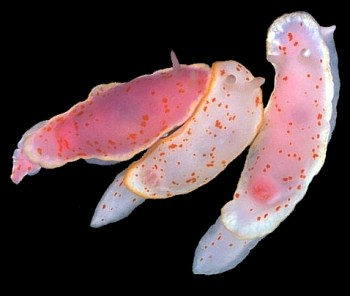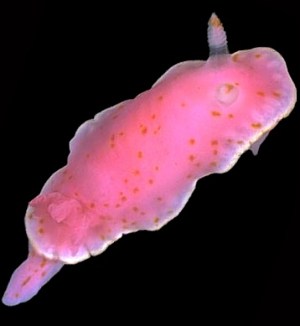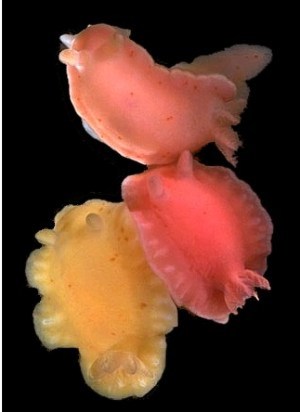
Noumea haliclona
(Burn, 1957)
Order: NUDIBRANCHIA
Suborder: DORIDINA
Superfamily: EUDORIDOIDEA
Family: Chromodorididae
DISTRIBUTION
Southeastern Australia (New South Wales, Victoria, Tasmania)
PHOTO
UPPER RIGHT: Ben Buckler, North Bondi, Sydney, New South Wales. 12m, March 1982. Three colour forms, 12-17mm long.
LOWER LEFT: Flinders, Westernport Bay, Victoria. March 1986. 19mm long.
LOWER RIGHT: Stanley, northern Tasmania. 12m, June, 1985. Three colour forms approx 15mm long alive. PHOTOS: Bill Rudman.
This small chromodorid is common in south eastern Australia both intertidally and sublittorally from northern New South Wales, to Victoria and Tasmania. It is one of the red-spotted colour group of chromodorids from this region and exhibits both colour variation within a region [sympatric variation] & distinctive regional colour forms [allopatric variation], which are illustrated on this page. There are no distinguishing anatomical features between the regional colour morphs. Externally, small scattered red or orange spots, and a red or orange mark on the front of the rhinophore club are the two characters which link these forms together. They feed on a range of pink and yellow aplysillid sponges.
New South Wales colour form: White or pink with small scattered red or orange spots. Gills and rhinophores match the colour of the body, and there is a red or orange mark on the anterior edge of the rhinophore club. There is a bright yellow or orange edge to mantle, but this is sometimes very faint or absent, especially in juveniles.
Victoria Colour form: Body and mantle pink with a white edge to the mantle and scattered small orange-red spots. Red-orange spot on anterior edge of rhinophore club.
Tasmania Colour form: Yellow or shades of Pink, with scattered small orange or red spots. Edge of mantle a translucent watery colour, not opaque white as in Victoria and NSW animals.
NSW specimens have been exhaustively studied (Avern, 1986) and the background colour is presumably genetically based because it is not the result of uptake of sponge pigment. The presence of direct development in this species and a pink colour form throughout its range, would suggest that a southern origin rather than a more recent tropical origin, is more likely for this species. It is possible that the pink Victorian or pink or yellow Tasmanian form is ancestral. Colour in those forms matches exactly their food sponge and can be considered most probably to be cryptic. Similar pink and yellow colour states can be found in the sympatric Verconia verconis. Although the same, or similar, pink and yellow aplysillid sponges are found in NSW, it is of interest that in this region there is also a white colour state, and both pink and white forms have a yellow border. This white state, with red spots and a yellow border is clearly no longer cryptic, and approximates well the predominant red-spotted colour group in this region.
They feed on a range of aplysillid sponges. See separate pages on each regional colour form.
Tasmania; Victoria; New South Wales.
See Mimicry between red spotted species in south-eastern Australia.
References:
• Rudman, W.B. (1983) The Chromodorididae (Opisthobranchia: Mollusca) of the Indo-West Pacific: Chromodoris splendida, C. aspersa and Hypselodoris placida colour groups. Zoological Journal of the Linnean Society, 78: 105-173.
• Rudman, W.B. (1986) The Chromodorididae (Opisthobranchia: Mollusca) of the Indo-West Pacific: Noumea flava colour group. Zoological Journal of the Linnean Society, 88: 377-404.
•Rudman, W.B. (1991) Purpose in Pattern: the evolution of colour in chromodorid nudibranchs. Journal of Molluscan Studies, 57, (T.E. Thompson Memorial Issue):5-21.
•Avern, G.J. (1986) The biology of the nudibranch mollusc Noumea haliclona (Burn, 1957). M.Sc. Thesis, University of Sydney (unpublished).


Rudman, W.B., 2000 (May 30) Noumea haliclona (Burn, 1957). [In] Sea Slug Forum. Australian Museum, Sydney. Available from http://www.seaslugforum.net/factsheet/noumhali1
Related messages
-
Noumea haliclona from Victoria, Australia
From: Trevor McMurrich, August 21, 2006 -
Noumea haliclona from Victoria, Australia
From: Perry Davis, May 19, 2006 -
Noumea haliclona from South Australia
From: Dennis Hutson, February 14, 2005 -
Noumea margaretae? from New South Wales
From: Judith Martin, February 26, 2001 -
Noumea haliclona from Sydney
From: Noel Conlon , June 8, 2000 -
Colour variation in Noumea haliclona
From: Bill Rudman., June 8, 2000
